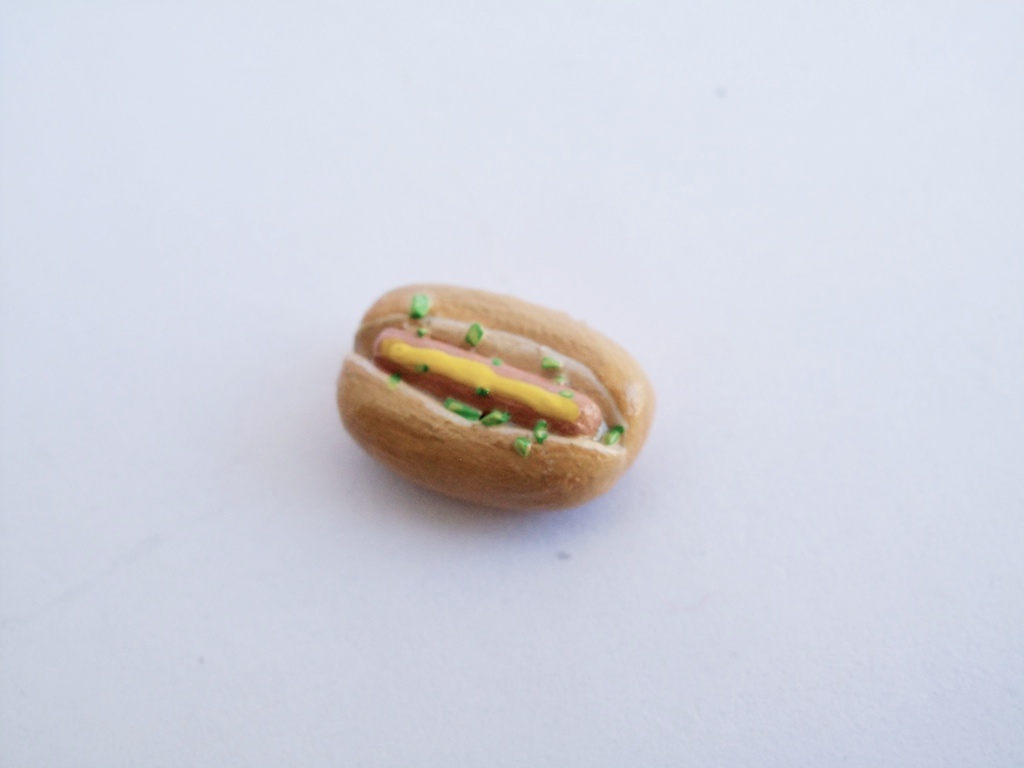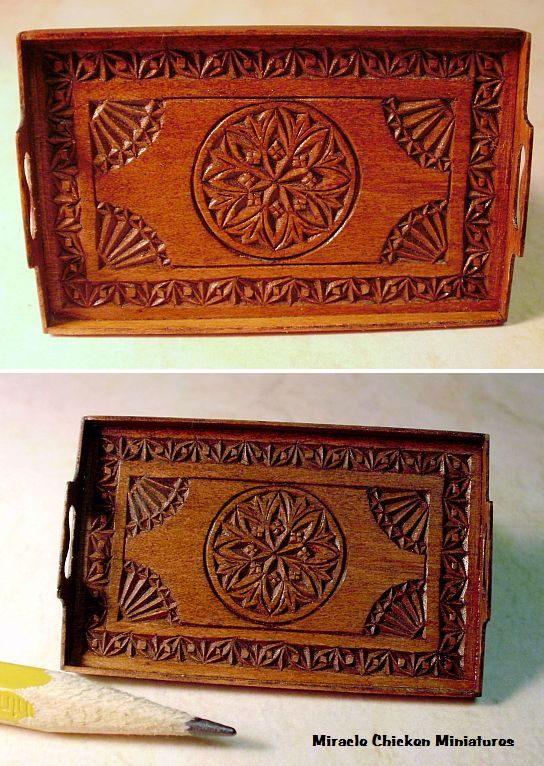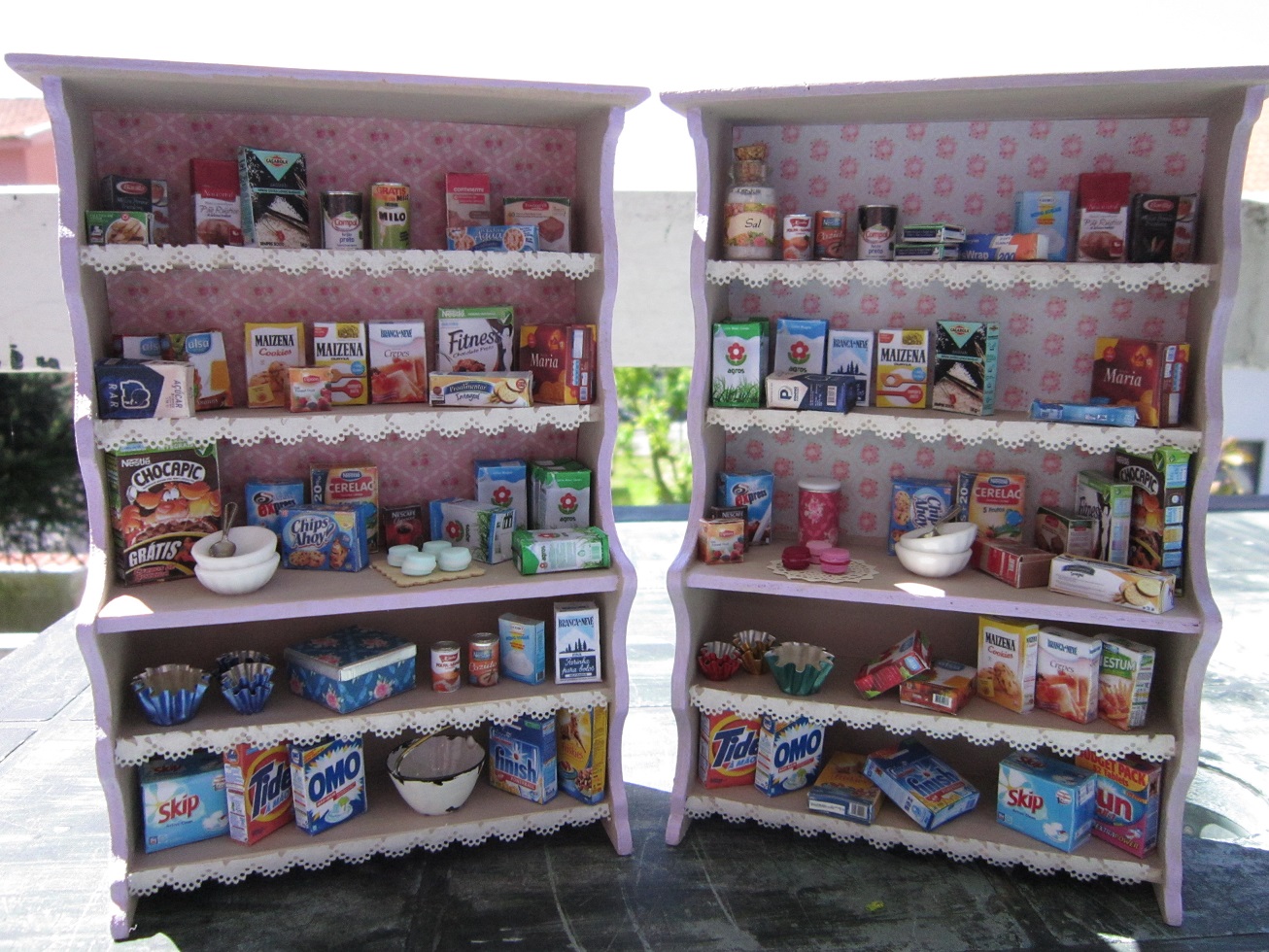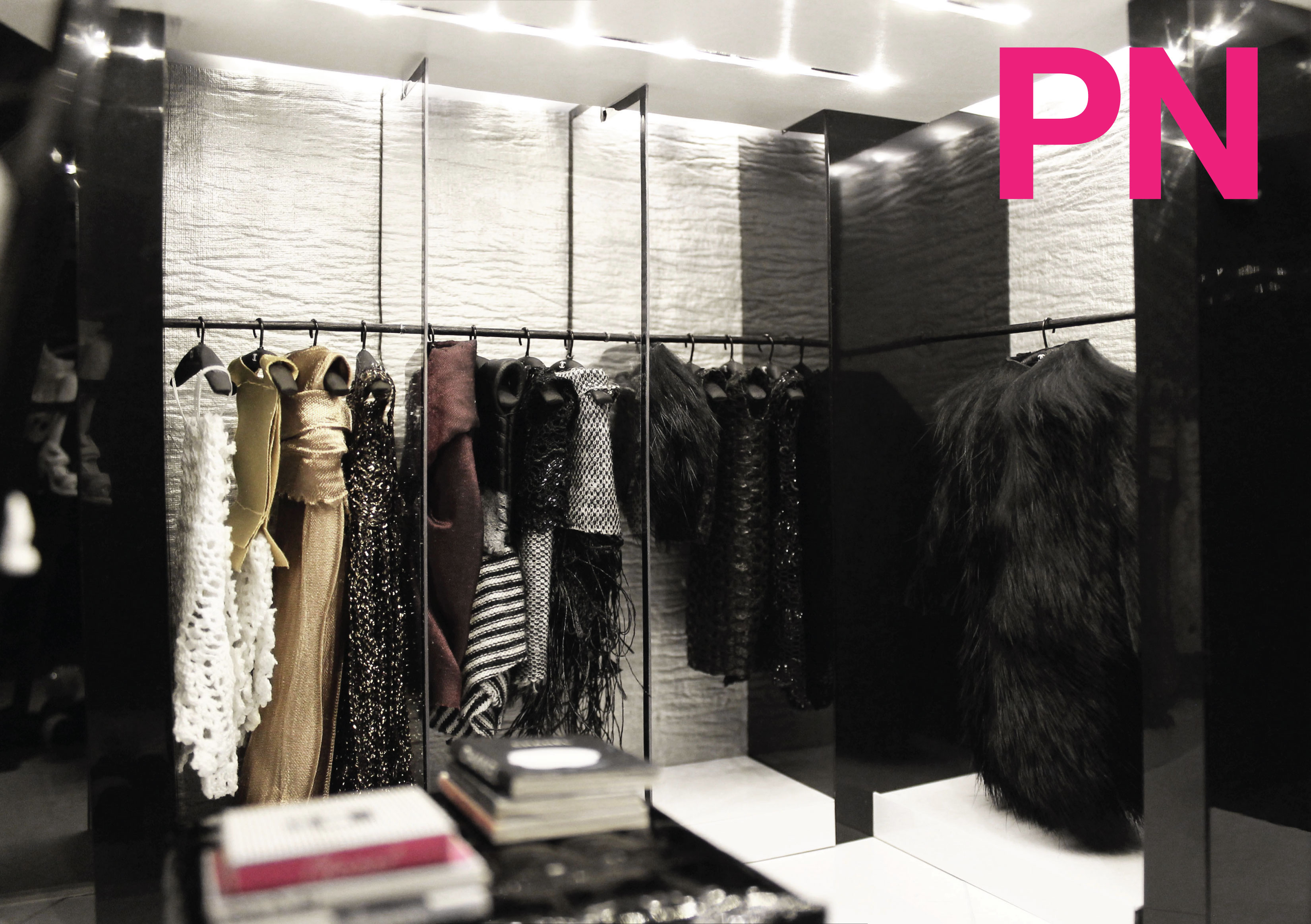Mackenzie McAlpin Miniatures
| Website & Shop | #mackenzieminis & Instagram | Daily Mini Studio Visit |
What are some of your earliest memories that involve miniatures?
 My mother made miniatures, so I remember watching her make all kinds of things. One of the coolest things she did was buy cheap Santa Claus figures and then she’d make a new face and sometimes even change their clothes, and then fill Santa’s bag with miniatures themed around a family’s hobbies. I always thought that was such a great way to make money and get to do what she loved. Mini making was just something she did on the side.
My mother made miniatures, so I remember watching her make all kinds of things. One of the coolest things she did was buy cheap Santa Claus figures and then she’d make a new face and sometimes even change their clothes, and then fill Santa’s bag with miniatures themed around a family’s hobbies. I always thought that was such a great way to make money and get to do what she loved. Mini making was just something she did on the side.
What kind of miniatures did your mom make?
Besides the Santa dudes, I remember her having a friend make a wooden Noah’s Ark and she made all the animals, two of everything she could think of. She made a lot of holiday-themed things, it was a way for her to earn extra money.  She was a single mother with 5 kids so, she really needed the extra. Heart necklaces for Valentine’s Day, mini Santas and snowmen or snowwomen for Christmas, pumpkins with willow tree branches as the stems, Fourth of July flags with glitter… you name it. I still have some of the little guys she made, I have a Santa, an alligator, a bird, and a few others. She was so fun to watch. She worked with polymer clay and acrylic paints. That’s what I use too, I didn’t stray far from what I knew.
She was a single mother with 5 kids so, she really needed the extra. Heart necklaces for Valentine’s Day, mini Santas and snowmen or snowwomen for Christmas, pumpkins with willow tree branches as the stems, Fourth of July flags with glitter… you name it. I still have some of the little guys she made, I have a Santa, an alligator, a bird, and a few others. She was so fun to watch. She worked with polymer clay and acrylic paints. That’s what I use too, I didn’t stray far from what I knew.
How did your mom’s work in miniatures inspire you to create your own?
 Making miniatures was something that I just happened upon. I wanted to be a part of a group art show and decided I would make a miniature orange tabby cat. That was the first mini I made, as an adult. While I was making it I felt like my Mom was there helping me. It made me laugh… as if she was sooo happy that I picked her medium to work with. That felt really amazing. Doing something my Mother did. I feel a huge connection to her when I work. Also, I should mention that my Mother passed away 6 years ago… so it feels extra special to feel a connection with her through something she did, it makes the work even more important to me.
Making miniatures was something that I just happened upon. I wanted to be a part of a group art show and decided I would make a miniature orange tabby cat. That was the first mini I made, as an adult. While I was making it I felt like my Mom was there helping me. It made me laugh… as if she was sooo happy that I picked her medium to work with. That felt really amazing. Doing something my Mother did. I feel a huge connection to her when I work. Also, I should mention that my Mother passed away 6 years ago… so it feels extra special to feel a connection with her through something she did, it makes the work even more important to me.
How long have you been creating works of art and photography?
 I have been making art for so long. I feel like we are all artists starting out. Some of us choose different paths, but creativity is so strong in us as children. I was lucky to have a mother that nurtured that part of me. She loved every little thing we made, even if it was leaves and sticks in a paper bag, she loved it.
I have been making art for so long. I feel like we are all artists starting out. Some of us choose different paths, but creativity is so strong in us as children. I was lucky to have a mother that nurtured that part of me. She loved every little thing we made, even if it was leaves and sticks in a paper bag, she loved it.
I started to get more serious about art in high school, because my art teacher, Tryon, ruled. She let me get into photography, but we didn’t have a photo department. We had to work with what we had, so I did a lot of collages with my photos (developed at CVS) and magazine cut-outs (National Geographic mostly). I loved them. I ended up going to college for Fine Art Photography and I still loooove making collages.
As for miniatures, I’ve been creating them for 2 years now. It’s still really new for me.
 Describe the pieces from your most recent collection.
Describe the pieces from your most recent collection.
The mini boob pots that I make are a collaboration with my friend Isaac Nichols, he makes life-sized boob pots for actual plants. I always wanted some of his pots, but I couldn’t afford them, so I decided to make mini versions of them. Turns out, the minis were a big hit. I also make lots of food and handfuls of jewelry, little mugs, plants, beauty supplies, naked ladies dancing, animals, pretzels, and… and… and, well… I like to make lots of things. I’ve also just started a series of shadow boxes, so hopefully I’ll have a gallery show at some point.
Daily Mini recently visited Mackenzie’s Studio — see the photos here!
Why miniatures?
Without feedback from friends and family, I probably wouldn’t be making miniatures right now at all. They are who makes this a “thing” for me. I can talk myself out of everything pretty quickly, so having support from them keeps me going.

Do you create miniatures on a full-time basis?
I do not. I am a full-time odd job kinda gal. I babysit, I am a bookkeeper for a couple different companies, I work as a Production Assistant sometimes, I help teach little kids art… oh man, I have a long list of things that I’ve been doing for the past 10 years in Philadelphia. This is a rad place to make art and make a living. The community here is so supportive and I am lucky to have the friends that I have and be surrounded by people who understand my lifestyle. I am so very lucky.
 Tools, techniques or materials you can’t live without?
Tools, techniques or materials you can’t live without?
Cheap acrylic matte finish paint, tweezers, music (I consider this to be a tool, without it, I get nothing done), sarcasm, my cat, and this weird little pencil that helps me shape each mini and at this point is coated with old clay and paint… it’s the best.
Advice for beginner artists?
Make what you want, how you want it, and keep at it. DO NOT try to be perfect. Let your personality shine through; that’s what people are drawn to in art, or at least that’s what I’m drawn to. Oh, and always work with good light.
What’s your most beloved miniature?
I don’t just have one. That’s the best part of miniatures! You can have a million beloved teeny things and they don’t take up that much space. BUT, I would say all the minis my Momma made, they are very dear to my heart. It’s cool to look at the way she made them and compare it to how I would make the same thing. I also have these really weird little pieces my boyfriend made me. One is a little mouse-like thing made out of clay and feathers. I call her Face Veil. And the other is a peanut on a piece of wood… I absolutely love them. They are the first gifts he gave me, and they make me smile.
It’s cool to look at the way she made them and compare it to how I would make the same thing. I also have these really weird little pieces my boyfriend made me. One is a little mouse-like thing made out of clay and feathers. I call her Face Veil. And the other is a peanut on a piece of wood… I absolutely love them. They are the first gifts he gave me, and they make me smile.
What’s the most difficult mini you’ve ever attempted to create?
Custom miniatures are rough for me. I feel a lot of pressure and anxiety because I want the animals to look right, I want the person to be happy with their mini. Somehow they always turn out well, and I end up loving them, but it’s a hard thing to get started.  I’m sure I overthink it. I have to take my own advice here and stop trying to make it perfect, because that’s impossible. Also, I’m sure my most difficult miniature is still to come.
I’m sure I overthink it. I have to take my own advice here and stop trying to make it perfect, because that’s impossible. Also, I’m sure my most difficult miniature is still to come.
What’s to come from Mackenzie McAlpin?
I’ll be working on updating my website off and on, as well as working on custom mini orders and OH! I’ll be selling minis at Art Star Pop Up Market at Spruce Street Harbor Park on July 25 (I will update my Instagram and my website accordingly). I also have a piece in the Fleisher Art Memorial Faculty Show right now.
What inspires you? 
I can’t think of any one thing in particular as a source of inspiration… but I am definitely influenced by Miranda July, my family, Amy Sedaris, Billy Dufala, Isaac Nichols, LIFES HAPPENINGS, Gabriel Orozco, dollar stores, childhood, animals, boobs, women’s bodies, flowers, the sky, my cat, the moon, the sun, nature in general, people who work their butts off, Nan Goldin, routines in life, food, relationships, mistakes, children’s encyclopedias, sustainability, Mexico, Africa, music, rocks, Outsider Art, Folk Art, love, laughter, and that list could go on and on and on…
 What are some of the most memorable miniatures you’ve seen?
What are some of the most memorable miniatures you’ve seen?
Dalton Ghetti’s carvings are so perfectly wonderful. Also, Anatoly Konenko’s smallest aquarium in the world is crazy. I went to the Philadelphia Miniaturia in New Jersey last year and those people are no joke. They blow my mind.
Other activities you enjoy?
One of my favorite hobbies is Windowkitty on Tumblr and @windowkitty on Instagram. I get soooooooo much joy out of this. I started doing it probably 8 years ago and still love it.
Anything else you’d like to add?
Everyone should know that I like to laugh, love and have fun ’cause life is so short.
To see many mini more Mackenzie McAlpin Miniatures, visit Mackenzie’s website or check out #mackenzieminis and @kenzaloolee on Instagram! To see photos from a recent Daily Mini Studio Visit, click here!




























































